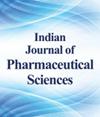青光素B通过激活NRF2/HO-1通路缓解帕金森病模型大鼠运动障碍炎症和氧化应激
IF 0.4
4区 医学
Q4 PHARMACOLOGY & PHARMACY
Indian Journal of Pharmaceutical Sciences
Pub Date : 2023-01-01
DOI:10.36468/pharmaceutical-sciences.1175
引用次数: 0
摘要
分析青绿素B通过激活核因子红系2相关因子2/血红素加氧酶-1通路,减轻帕金森病模型大鼠运动障碍、炎症反应和氧化应激。将150名成人分为5组,分别为假手术组(健康小鼠)、帕金森组及低剂量组(帕金森+20 ng/ml)、中剂量组(帕金森+40 ng/ml)、高剂量组(帕金森+60 ng/ml),各组0 d调整步数、前掌动作次数、阳性反应次数无差异;帕金森组第3 d剂量组较假手术组减少;第7 d,帕金森组、剂量组的步数均较假手术组减少。帕金森病组和剂量组肿瘤坏死因子- α、白细胞介素-1 β和白细胞介素-6均较假手术组升高,而剂量组均较帕金森组降低。帕金森组、剂量组大鼠的反应性氧化应激浓度和髓过氧化物酶活性均较假手术组升高,剂量组较帕金森组降低;超氧化物歧化酶活性明显低于假手术组。核因子、红细胞2相关因子、血红素加氧酶-1水平在帕金森组、剂量组均高于假手术组,且剂量组均高于帕金森组。低、中、高剂量组均随剂量的增加而升高(p<0.05)。青霉素B可以缓解帕金森病模型大鼠的运动障碍,降低大鼠的炎症反应和氧化应激反应,其相关机制是通过激活核因子红系2相关因子2/血红素加氧酶-1通路。本文章由计算机程序翻译,如有差异,请以英文原文为准。
Glaucocalyxin B Relieving Dyskinesia Inflammation and Oxidative Stress in Parkinson's Disease Model Rats by Activating the NRF2/HO-1 Pathway
To analyze that glaucocalyxin B can alleviate dyskinesia, inflammatory response and oxidative stress in Parkinson's disease model rats by activating the nuclear factor erythroid 2–related factor 2/heme oxygenase-1 pathway. 150 adults were divided into 5 groups, namely, the sham operation group (healthy mice), the Parkinson's group and the low-dose group (Parkinson+20 ng/ml) glaucocalyxin B), the medium-dose group (Parkinson+40 ng/ml glaucocalyxin B) and high-dose group (Parkinson+60 ng/ml glaucocalyxin B). The number of adjustment steps, the number of forepaw movements and the number of positive reactions in each group at 0 d have no difference; on the 3rd d in the Parkinson's group, dose group were reduced than in the sham operation group; on the 7th d, the number of steps in the Parkinson's group, and dose groups were reduced than the sham operation group. The tumor necrosis factor-alpha, interleukin-1 beta and interleukin-6 in the Parkinson's disease group, and dose groups were raised than those in the sham operation group, while these in the dose groups were reduced than in the Parkinson's group. The reactive oxidative stress concentration and myeloperoxidase activity of the Parkinson's group, dose group were raised than those of the sham operation group, while in the dose group were reduced than the Parkinson's group; superoxide dismutase activity level was reduced than the sham operation group. The levels of nuclear factor erythroid 2-related factor and heme oxygenase-1 in the Parkinson's group, dose groups were raised than those in the sham operation group, while in the dose groups were raised than those in the Parkinson's group. Further, in the low, medium and high dose groups increased with the increase of dose (p<0.05). Glaucocalyxin B can alleviate the dyskinesia of Parkinson's disease model rats and reduce the inflammatory response and oxidative stress response in rats, its relevant mechanism via activating the nuclear factor erythroid 2-related factor 2/heme oxygenase-1 pathway.
求助全文
通过发布文献求助,成功后即可免费获取论文全文。
去求助
来源期刊

Indian Journal of Pharmaceutical Sciences
PHARMACOLOGY & PHARMACY-
自引率
0.00%
发文量
0
审稿时长
2 months
期刊介绍:
The Indian Journal of Pharmaceutical Sciences (IJPS) is a bi-monthly Journal, which publishes original research work that contributes significantly to further the scientific knowledge in Pharmaceutical Sciences (Pharmaceutical Technology, Pharmaceutics, Biopharmaceutics, Pharmacokinetics, Pharmaceutical/Medicinal Chemistry, Computational Chemistry and Molecular Drug Design, Pharmacognosy and Phytochemistry, Pharmacology and Therapeutics, Pharmaceutical Analysis, Pharmacy Practice, Clinical and Hospital Pharmacy, Pharmacovigilance, Pharmacoepidemiology, Pharmacoeconomics, Drug Information, Patient Counselling, Adverse Drug Reactions Monitoring, Medication Errors, Medication Optimization, Medication Therapy Management, Cell Biology, Genomics and Proteomics, Pharmacogenomics, Bioinformatics and Biotechnology of Pharmaceutical Interest). The Journal publishes original research work either as a Full Research Paper or as a Short Communication. Review Articles on current topics in Pharmaceutical Sciences are also considered for publication by the Journal.
 求助内容:
求助内容: 应助结果提醒方式:
应助结果提醒方式:


